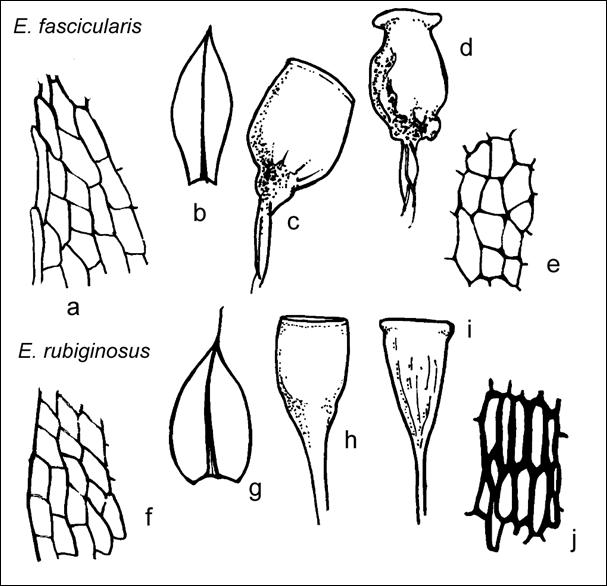Rusty cord-moss (Entosthodon rubiginosus) COSEWIC assessment and status report: chapter 3
Species Information
Name and classification
Scientific name:
Entosthodon rubiginosus (Williams) Grout
Pertinent synonyms:
Funaria rubiginosa Williams
Common name:
Rusty cord-moss (earlier name: wrinkled flask moss; McIntosh and Paige 2001)
Family:
Funariaceae
Major plant group:
Mosses (Musci)
The Funariaceae is a large moss family characterized by small species with a great degree of vegetative similarity, with most taxa having broad, light green leaves and large, pale leaf cells (Crum and Anderson 1980). Most species are considered to be short-lived, either annual or biennial (Grout 1935, Lawton 1971). Genera within the family are distinguished by differences in the sporophyte (spore producing generation): by the shape, size, and straightness of the capsule (spore sacs), and by the presence, absence, or degree of development of the peristome (a fringe of tooth-like appendages surrounding the mouth of the capsule).
The genus Entosthodon consists of a group of diminutive species which have derived their name from the peristome which, when present, is inserted well inside the mouth of the capsule. Entosthodon has shortly exserted, erect, symmetrical, and operculate capsules (with lids), and moderately large spores. Members of this genus often colonize ephemeral habitats that are repeatedly, but inconsistently, available in the same area, rather than depending on wind dispersal of spores to reach more widely distributed suitable areas.
There are twelve species of Entosthodon in North America, with only E. rubiginosus and E. fascicularis found in Canada. Both of these species are restricted to British Columbia (Anderson et al. 1990; Ireland et al. 1987).
Description
The following description has been derived from Grout (1935), Lawton (1971), McIntosh & Paige (2001), and from personal observations. Figure 1 illustrates many of the characters described here. Figure 2 is a photograph of a small patch of Entosthodon rubiginosus from the White Lake area of southern British Columbia.
Entosthodon rubiginosus is a small, 2-3(-5) mm tall, pale green to green acrocarpous (producing female structures and sporophytes at the tips of the main stems) moss that grows as individual stems or in tiny patches. It is inconspicuous and often hidden among other mosses. Mature leaves are crowded at the summit of an erect stem and range in length from 1.5-2.4 mm, and average about 1 mm wide. They are ovate to, occasionally, somewhat obovate, acuminate to acute, erect-spreading when moist, and slightly contorted when dry. The leaf margins are usually plane, rarely slightly uneven above, and lack a clearly defined border although some marginal cells are occasionally slightly shorter than the adjacent laminal cells. The irregularly rectangular to rhomboidal upper laminal cells are thin-walled and range in size from 40-60 µm long to 20-30 µm wide. Basal leaf cells are rectangular-elongate. The costa, or mid-rib, usually ends below the apex in lower stem leaves, but is excurrent in the upper leaves.
Figure 1Footnotea. Comparison of Entosthodon fascicularis (a – e) and E. rubiginosus (f – j); a, f: upper leaf margins (X 175); b, g: stem leaves (a:X12, b:X16); c, h: fresh capsules (c: X12, h: X16); d, i: dry capsules (d: X12, i:X16); e, j: upper cells of capsule walls (X 175); a, b, and f modified from Lawton, 1971, all others by T. McIntosh.

Figure 2. Plants and young sporophytes (partially covered by calyptrae) of Entosthodon rubiginosus from the White Lake area (+/- X 18; Photograph by Ole Westby).

The sexuality of Entosthodon rubiginosus is uncertain. It is probably autoicous, with male and female organs on the same stem, since sporophytes appear to be produced on most plants annually. The sporophytes of E.rubiginosus are small, andrange from 4-5(-7) mm in height. They mature in the late winter and into the spring, and, in British Columbia, the sporophytes usually remain obvious into the autumn, even though the leaves tend to dry out and become inconspicuous. It has relatively large, distinct calyptrae (vegetative hoods that protect the young sporophyte), and they completely cover the maturing capsules. The calyptrae have long thin tips and are split near the base. Its capsules are erect, somewhat pyriform (pear-shaped), red- to yellow-brown when mature, and usually somewhat contracted below the mouth and wrinkled when dry. The mouth of the capsule is bordered by a series of transversely-rectangular cells below which are cells that are elongate and thick-walled (this character separates it from the similar E.fascicularis, which has small and irregularly even-sized cells below). The operculum is conic and the peristome is rudimentary or absent. Spores are papillose and vary in size from 25-35 micrometers.
Taxonomic keys and additional illustrations are found in Grout (1935) and Lawton (1971). Discussion about Entosthodon rubiginosus and related taxa is found in McIntosh (1986).
Page details
- Date modified: